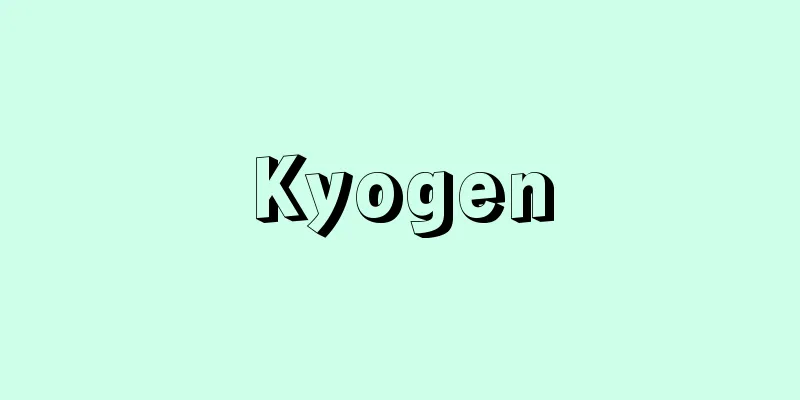Kyogen

|
A classical Japanese performing art. A comedy that is mainly expressed through gestures and lines. Since the early Muromachi period, it has maintained a close relationship with Noh, so Noh and Kyogen are collectively called "Nohgaku." [Kobayashi, Responsible] Meaning and nameThe word "kyogen" is an old Chinese word that means words that are abnormal or unreasonable, or jokes or nonsense. In Japan, it was already used in the "Manyoshu" and is pronounced "tawagoto." In the Heian period, it also became popular as the compound word "kyogen kigo" (words used to modify and express things that are not true, and by extension, novels and other writings), but later it gradually came to be used as a common noun synonymous with "kokkei." Meanwhile, it was during the Nanboku-cho period that this name came to refer to a type of performing art, first appearing among the various arts of the Ennen era, and in the Muromachi period, it became established as a word to refer to humorous arts performed alongside Noh. From the mid-Edo period onwards, the term "Kabuki Kyogen" became common and Kyogen came to be used as another name for "theater", so the original Kyogen was sometimes called "Noh Kyogen". However, after World War II, its value was reevaluated and the name was restored, and it became universally understood that Kyogen refers to Nohgaku Kyogen. [Kobayashi, Responsible] History and current situationKyogen is considered to have inherited the tradition of humorous imitation among the various arts of Sangaku, which was introduced from China during the Nara period. In the Heian period, Sangaku came to be called Sarugaku, which differentiated into Noh, a serious musical and dance drama, and Kyogen, a humorous dialogue drama, during the Kamakura period. Then, in the early Muromachi period, when Zeami and others of Yamato Sarugaku refined Sarugaku Noh into a form similar to that of today, Kyogen was still nothing more than an improvised skit, but it was incorporated into the Sarugaku troupe and came to be dominated by Noh. At the time, there were Sarugaku troupes throughout the Kinki region, not only in Yamato, but also in Omi, Uji, Tamba, Settsu, and other areas, each with its own Kyogen performer, but during the turmoil of the Warring States period, it gradually declined and was incorporated into the flourishing Yamato Sarugaku, or formed into a troupe of Kyogen performers alone, centered in Kyoto. Then, in the late Muromachi period, when Kyogen took on a form as a theatrical performance, first the Okura school was established by the Kyogen actors of Yamato Sarugaku, and then in the early Edo period, the two emerging schools, Sagi and Izumi, were established. The Tokugawa Shogunate designated Noh as ceremonial music for the samurai class and provided stipends for its actors, so the Okura and Sagi schools were directly under the Shogunate, while the Izumi school received stipends from the Owari Tokugawa clan and the Kaga Maeda clan and also performed at the Imperial Court. Kyogen performers of these three schools were also employed by various local clans, and the Edo period went by peacefully. However, after losing their protectors during the Meiji Restoration, the Kyogen world fell into chaos, and by the mid-Meiji period the head families of both the Okura and Sagi schools were abolished, and by the early Taisho period the Izumi school was also abolished. In Tokyo, the Miyake Tokuro family of the Izumi school and their followers, as well as the Yamamoto Toujiro family of the Okura school, who had come to the new capital from Kyoto, Kanazawa and other places when the capital was moved, and in Kyoto and Osaka the Shigeyama Sengoro family and the Shigeyama Chuzaburo family of the Okura school, all continued to pass on the art through their disciples, but in the early Meiji period the main Kyogen actors of the school joined Azuma Noh Kyogen, and then became close to the Kabuki world, causing the Sagi school to finally fall into decline. In the Showa period, both the Okura and Izumi schools re-established their head families. In Tokyo, there are the Okura Yaemon family, the head of the Okura school, the Yamamoto Tojiro family, the Zenchikujuro family, the Izumi school's Nomura Manzo family, the Nomura Mansakusha family, the Miyake Ukon family, and the head Izumi family. In Kyoto and Osaka, there are the Shigeyama Sengoro family, the Shigeyama Chuzaburo family, and the Zenchiku family that split off from the Chuzaburo family, and in Nagoya, there is the Izumi school's Nomura Matasaburo family and the Kyogen Kyodosha, an association of Kyogen performers from the same school, all of which are active as performance units in their respective regions. The style of performance reflects the local characteristics rather than the school, with Tokyo forming intellectual, standardized art, Kyoto and Osaka forming emotional, realistic art, and Nagoya forming art that is somewhere between the East and the West. A notable trend in the world of Kyogen after the Second World War was that it was liberated from its subordinate position to Noh, and its light comedy and simple stage expression were widely recognized again by the general public. Then, from around 1955, Kyogen actors began to take part in new styles of original theatre, or in theatre of other genres such as Kabuki, and performed Greek theatre in collaboration with modern theatre actors, which attracted attention. Furthermore, through activities to spread Kyogen overseas, today Kyogen is highly regarded from a global perspective. [Kobayashi, Responsible] Sanbaso, Furyu, Ma Kyogen, Hon KyogenThe arts performed by kyogen actors are divided into (1) Sanbaso (called "Sanbaso" in the Okura school) and Furyu (furyu), (2) Ai-kyogen, and (3) Hon-kyogen. [1] Sanbaso and Furyu are the kyogen actors' performances in the ritual Noh play "Okina". Sanbaso is a dance performed by a single performer to pray for a good harvest after the Okina, played by the shite actor, has left the stage. It is divided into the first half, "Momi no dan," in which the performer dances heroically without a mask, and the second half, "Suzu no dan," in which the performer dances lightly wearing a black formality mask and holding a bell. Furyu is a simple play with a happy plot featuring many actors dressed in gorgeous attire. [2] Ai is a role in a Noh play that is taken on by a Kyogen actor, and the role is called ai for short. It can be broadly divided into katariai, which explains the theme and content of the piece in simple terms during the shite's intermission, ashiraiai, which co-stars with other Noh actors, and gekiai, in which two or more Kyogen actors perform a skit. Although it is generally a low-ranking role, it can affect the atmosphere of a Noh play and should not be overlooked. [3] Hon-kyogen is a form of theatre with an independent plot, but when the word "kyogen" is used, it usually refers to Hon-kyogen. The leading role is called shite, the supporting role is called ado, and in the Izumi school, all actors except for ado are called ko-ado. In addition, several people with the same character who appear together, such as pilgrims or cherry blossom viewers, are called tachishu, and their leader is called tachishira. The current pieces (the repertoire officially recognized by the school) are 180 pieces in the Okura school (however, the Shigeyama Sengoro and Yamamoto Tojiro schools each have 200 pieces), 254 pieces in the Izumi school, and 191 common piece, for a total of 263 pieces in both schools. It is usually performed by 2 to 4 people, and there are about 40 pieces called "Ozemono" that require several people, but there are very few pieces that require more than a dozen people, such as "Touzumo", "Taikooi" and "Romusha". Most performances last 20 to 40 minutes, and only "Hanago" and "Tsurigitsune" last more than an hour. In the time of Zeami, it was already the rule that honkyogen should be performed between Noh plays, and this has continued to the present day, but alternating between Noh and Kyogen, two performing arts with contrasting characteristics, is a clever performance wisdom that is not found even overseas. However, "Kyogen-zukushi", which consists of only Kyogen plays, has also been performed since the Azuchi-Momoyama period, and has become particularly popular in recent years. [Kobayashi, Responsible] Characteristics of this KyogenThe main features of the content of this Kyogen are its comedic quality and its down-to-earth appeal. The laughter of Sarugaku in the Heian period was thought to have been quite obscene, but Zeami demanded that Kyogen should have laughter that "included enjoyment in the laughter," that is, a refined and gentle humor. Furthermore, throughout its history, it was performed on the same stage as aristocratic Noh, and especially in the Edo period, it was designated as a samurai-style musical and directly subordinated to the samurai, so the humor gradually became more refined and sublimated. The humorous elements seen in Kyogen today include the "celebratory nature" that was the spiritual pillar of the existence of medieval performing arts, and the "satirical nature" that reflects the trend of overthrowing the ruling class, but what dominates many pieces is what is called "humorousness," which is laughter that has no purpose and is simply fun. The Muromachi period was a time of turmoil, and the social climate was unstable and brutal, but it was precisely because of this time that common people were able to accumulate energy for upward mobility. The humor of Kyogen can be said to be the laughter of the Muromachi people, who reflected this social consciousness and celebrated this world. There are only a few Zatō Kyogen pieces that do not include laughter, such as "Kawakami," "Kiyomizu Zatō," and "Tsukimi Zatō," but many of these are excellent pieces that exude pathos or poetry, broadening the range of qualities that Kyogen can encompass. Some of the Kyogen plays are based on collections of tales from previous periods, but these are few and far between; most are modern plays from the Muromachi period based on contemporary social conditions. The characters span all social classes, and even include gods, Buddhas, devils, animals, and plants, with a wide variety of shite characters alone. While the plays are critical of those in authority, such as feudal lords and priests, they give the most attention to Tarokaja, a subordinate servant of samurai and local lords, known as genin, and are rather sympathetic to social outcasts such as gamblers, con artists, thieves, and bandits, and do not treat them as true villains. Famous historical figures such as Ariwara no Narihira are merely presented as typical women-lovers, while Asahina no Saburo Yoshihide and Chinzei Hachiro Tametomo are merely presented as representative of the strong, and demons and Enma are given the worldly characteristics of people of their time, such as lustfulness and poverty. Gods and Buddhas are also the objects of popular faith, on the level of the Seven Lucky Gods. The selection and characterization of these characters strongly conveys a commoner nature based on humanism. [Kobayashi, Responsible] Classification and contents of this KyogenThe most common classification of Kyogen is based mainly on the type of shite character. Below, I will outline the characteristics of the content of each type of Kyogen based on the Izumi school's classification, with some personal opinions added. [1] Waki Kyogen These can be subdivided into miscellaneous pieces, including the Kamimono (divine objects) in which gods bestow good fortune on people and perform a celebratory dance, the Kafumono (good fortune objects) in which negotiations between a generous rich man and a careless or quick-witted servant come to a happy conclusion, the Hyakushomono (farmers' stories) in which a provincial peasant happily pays his annual tax to a feudal lord in Kyoto, the Taro Kajamono (Taro Kaja), a monk who is tricked by a swindler in the capital and asks for something completely different from what he was ordered to, and a piece in which two merchants compete to be the first to arrive at a market, but they all have in common that they contain a joyous theme and invite harmonious laughter. For this reason, a separate category of Waki Kyogen remains, which is meant to accompany the Okina, regardless of the role. The collection includes 35 songs, including "God of Fortune," "Suehirogari," "Treasure Hammer," "Tsukushi no Oku," and "Nabe Yatsubachi." [2] Daimyo Kyogen Although they were called daimyo, they were merely local samurai. Although they acted arrogant, they were actually foolish or powerless, and the contradiction between their appearance and their inner selves invites laughter. However, since daimyo are generally cheerful and easygoing, the humor exudes a sense of gentle enjoyment rather than satire. There are 16 pieces in this series, including "Utsubozaru," "Kazumou," and "Onigawara." [3] Tarokaja Kyogen There are many Tarokaja who are clever and wise, but in Tarokaja Kyogen where they play the shite role, their flaws are generally obvious: stupid, lazy, timid, and fond of alcohol. However, they are characterized by their innocence and charm, and the laughter they exude is boundlessly cheerful. There are 45 plays in the series, including "Neongyoku," "Busu," "Boushibari," "Suouotoshi," "Chidori," and "Kirokuda." [4] Groom Kyogen After marriage, the groom visits his father-in-law for the formal groom-to-be ceremony. These can be divided into two types: groom-entry stories in which the groom makes a mistake due to immaturity or greed, and groom-seeking stories in which the aspiring groom runs away when he sees the girl's ugly face or exposes his incompetence and fails to become the groom. Groom-entry stories are considered to have a celebratory nature. There are 17 stories in this series, including "Futari Bakama" (Two People in Hakama) and "Funa Watashi Muko" (The Boat-crossing Groom). [5] Female Kyogen Kyogen does not have a female shite other than an old nun, and this includes married couples that depict the conflict between men and women within the family, and wives who are surprised at the ugliness of their prospective brides. In married couples, the wife is generally stronger and more competitive, which creates a humorous tale of a terrifying wife. There are 30 such plays, including "Kamabara," "Chigiriki," "Mikazuki," and "Hanago." [6] Oni Kyogen: These plays feature demons, Enma and Kaminari as shite, and the ignorance and powerlessness of these seemingly frightening creatures, who are trivially defeated by human wisdom and strength, invite comic humor. There are nine plays, including "Setsubun," "Kubihiki," and "Yao." [7] Yamabushi Kyogen Many of these plays are aimed at making fun of the Yamabushi, who appear imposing and boast about their powers, but whose prayers are completely ineffective. These plays have more of a fairy tale-like fun than satirical quality. There are nine plays in this series, including "Negi Yamabushi," "Kusabira (Mushroom)," and "Kagyu." [8] Shukke Kyogen Many of these plays satirize the greed, violation of precepts, and ignorance of monks, but there are also some that look on traveling monks who are single-mindedly seeking enlightenment with a kind gaze. In the Shinbochi Kyogen, the master and Tarokaja are replaced by the abbot and Shinbochi, and the humor is generally bright and fun. There are 25 plays, including "Syurōn," "Fuse No Sutra," "Natorigawa," and "Ochanomizu." [9] Zatō Kyogen: These include humorous plays with blind people as the main characters, and plays that exude pathos by depicting the wisdom and sorrow of disabled people. There are eight plays in this series, including “Dobukacchiri” and “Kawakami.” [10] Mai-Kyogen: A traveling monk listens to the stories of his hosts and performs a memorial service for the deceased. The ghost of the deceased appears and dances to recreate the scene of their final moments. This is a parody piece with a similar structure to Noh. There are seven pieces, including "Tsuen." [11] Kaeai Kyogen: These are highly independent kaeai (specially performed interlude kyogen) pieces that can also be performed on their own. There are six pieces, including "Sarumuko." [12] Zatsu Kyogen: This group includes plays that cannot be classified as above, so the content is miscellaneous. It includes plays with outlaws as shite. There are 56 plays in this group, such as "Chatsubo," "Urinusubito," "Akutaro," "Yoneichi," and "Buaku." In addition to the above, there are also bangaikyoku and new kyogen. Bangaikyoku are new works from the Edo period and after the Meiji Restoration, or semi-current pieces that incorporate pieces from other schools. The Okura school has 11 pieces, and the Izumi school has 27 pieces, but in reality, the Okura school rarely performs any pieces other than "Onigayado" by Ii Naosuke and "Nenohi" by Reizei Tametada, and the Izumi school rarely performs "Kenbutsuzaemon." Shinsaku Kyogen is a general term for hon-kyogen works created after the Meiji Restoration, and there are more than 120 trial performances, but the only ones that have been performed repeatedly are "Susugigagawa" by Iizawa Tadasu, "Hikoichibanashi" by Kinoshita Junji, "The Fox and the Space Alien" by Komatsu Sakyo, and "Shinigami" by Hoashi Masanori. Some of the Shinsaku Kyogen pieces, such as "Ne no Hi" and "Susugigagawa", have been incorporated into the extra-plays. [Kobayashi, Responsible] Directing and actingKyogen is performed on the Noh stage along with Noh. The reason why the direction and performance of Kyogen are called "kata" like Noh is probably because the direction and performance were categorized while being performed under the influence of Noh on the bleak stage for symbolic drama and dance drama. Therefore, although Kyogen's main elements are gestures and lines, it is essentially different from modern realistic drama. The posture with a slightly lowered waist and lowered center of gravity and the sliding foot movement are the same as Noh, but unlike everyday posture and walking, the lines have a unique intonation that is based on emphasizing the second sound of each phrase. The reason why training begins with dance and song called komaiutai and komai is to first acquire the foundations of acting such as vocalization, posture, and walking, and to cultivate the beautification of lines and the rhythm of gestures. The theatrical structure is simple and unpretentious. Most plays begin with a self-introduction by the characters, called "nanori," followed by either summoning the opposing actor or going around the stage in a "michiyuki" (traveling) to change the scene, after which the main plot begins. The ending can be classified into several types, such as a cornering, scolding, line ending, or sneezing ending for failure, or a shagiri ending, a laughing ending, or a chanting ending for reconciliation. The plays are also categorized in such a way that the introduction is done in the shosaki (front row) of the main stage for feudal lords and the like, and in the nanoza (front row) for others, and dialogue is mostly done in the nanoza and wakiza (front row). Furthermore, the plays are supported by many conventions, such as if a character is sitting on the kami (front row) or daisho-mae (front row) of the flute seat, or kneeling backwards in the kokenza (front row), it means that they are outside the progression of the play and are not onstage. However, Kyogen has not only shrunk its directing and acting due to the influence of Noh and the constraints of the stage. Even in a michiyuki, the movements are minimal in Noh, but in Kyogen, the performers circle the stage, and even in a crying pose, while in Noh the performers simply bring their palms close to their eyes, Kyogen uses the sound of a cry "Eeeeeh!", making it more realistic. There are also many scenes that require onomatopoeia, but instead of using tools, the actors themselves utter onomatopoeia while performing, such as "sara, sara sara sara" when opening a door, "zuka, zuka zuka, zukkari" when cutting through a bamboo fence with a saw, and "dobu, dobu dobu dobu, pisho pisho pisho" when the sake poured from the barrel runs out. In other words, Kyogen has skillfully combined realism and abstraction in directing and acting, and succeeded in creating a simple, refined, and unique style and humor. [Kobayashi, Responsible] Song, Dance and MusicThe term "Kyogen utai" refers collectively to the elements of song in Kyogen. Kyogen utai are often sung in conjunction with the development of the plot, as entertainment at drinking parties, to express joy or heightened emotions, or to cheer up the host or as drunken venting. However, in accordance with the operatic format, utai may be sung as an entrance song, with a shidai or issei chant as in Noh, or narrative content may be sung in the kiri (conclusion). Thus, there are approximately 150 pieces that include song elements, and while it is normal for the characters themselves to sing, there are approximately 35 pieces in which jiutai (chants) appear, mainly in the kiri. Kyogen songs can be broadly divided into Komaiutai (small dance songs), Tokubetsu Kyogen songs, and Shakuutai (also called Koutai). (1) Komai-uta is always accompanied by a dance called “komai,” and has artistic independence that allows it to be appreciated on its own. (2) Specified Kyogen-yo refers to songs sung in specific Kyogen plays that are not incorporated into Komai-yo, such as the monkey song in "Utsubozaru" and the Jizo dance in "Jizo-mai," which are either not accompanied by dance or have little artistic value when performed alone. (3) Sakeutai is sung while standing to pour drinks at a drinking party, and is sung while staggering about drunk. There are about a dozen short songs, such as "Za zan za, Hamamatsu no oto wa za zan za," including original pieces as well as pieces that are excerpts from Noh plays. As such, since Hon Kyogen has a strong element of folk songs, about 85 pieces are accompanied by hayashi (music accompaniment) (however, in cases where it is possible to omit the hayashi, such as when it is only necessary for the shijou part, it is often performed without it). Kyogen's music is generally elegant, and even if it has the same name as Noh, such as 'kakeri' or 'gaku', the technique is usually simplified. Furthermore, unlike Noh, the jiutai (chants) stand in a line behind the hayashiza (music troupe), and all the hayashi perform while sitting sideways, rather than sitting on floor cushions (shogi). [Kobayashi, Responsible] Masks, costumes and propsKyogen is generally performed soberly, but masks are used for special roles. The costumes are realistic, everyday and simple, in contrast to the splendor and extravagance of Noh. The kataginu worn by the Tarokaja and others often feature innovative designs, such as onigawara tiles, clappers, scarecrows, turnips and dragonflies, all over the back. These, along with the dyed designs of three umbrellas, millstones, drying nets and sailing boats scattered on the hakama of the kazari, show the common man's character of Kyogen. Kyogen does not use actresses, and only special roles use female masks, so women are represented by a costume of about 6 meters of white hemp called a binan, wrapped around the head, tied in front and hanging on either side of the face with both ends tucked into the obi. Sets and other large props are not used as much as in Noh. However, small props are used in abundance, such as realistic farm tools (hoes, hoes, sickles, clappers), sake vessels (cedar barrels, gourds), and rough objects (cutting boards, knives), which reflect the common people's nature of Kyogen. On the other hand, there are also symbolic examples such as the black hairpiece (a type of hair) tied to the end of a bamboo cane in "Cow and Horse" representing cows and the white representing horses, the feather broom in "Wild Goose Feudal Lord" representing geese, and the pear-shaped eboshi hat in "Kombu Seller" representing kelp.It is also noteworthy that the kudzu bucket is not only used as a floor stool, but also as a tea container in "Tea Pot" and a persimmon tree in "Persimmon Yamabushi," and its lid is cleverly repurposed as a cup, or the fan is closed to represent a sword, saw, or stone mill, or opened to represent a cup, choshi, or door. [Kobayashi, Responsible] The influence of KyogenKyogen is Japan's first comedic art form and has had a profound influence on later performing arts and literature. As a performing art, it is Kabuki that has inherited the blood of Kyogen the most. Kyogen actors from small Sarugaku troupes participated in the founding of Kabuki, and in the early Edo period, many Kabuki plays were adapted from Kyogen plays. However, most of these plays were no longer performed, and from the late Edo period onwards they were mainly incorporated into Kabuki dance, and only remains are today such plays as "Re-sowing the Vinegar Seeds" (Tongue-Out Sanba) and "Willow Thread Pulling Gohiiki" (Puppet Sanba), which were created from Sanbaso, "Tekuda no Wanaka Tsurihige" (Asahina Tsurigitsune) and "Tsurigitsune Sato no Kakewana" (Kuruwa Tsurigitsune), and "Hanabutai Kasumi no Saruhiki" (Utsubozaru), which was taken from "Utsubozaru". Also, since the Meiji period, works written in the Matsubamemono style, such as Fukuchi Ochi's "Suou Otoshi" and "Nininbakama," and Okamura Shiko's "Migawari Zazen," "Boushibari," "Chatsubo," and "Akutaro," have become part of the current Kabuki dance repertoire. In the music field, Chikamatsu Monzaemon used Kyogen lyrics in his Joruri, and there are many Nagauta and Jiuta pieces that use themes from Kyogen and lyrics from Komai-yo. In the field of literature, there are collections of haikai renga (linked verse poems) compiled in the late Muromachi period, such as "Inu Tsukubashu" and "Dokugin Senku," and in the Edo period, haiku and senryu poems borrowing phrases from kyogen. In addition, there are many short stories and rakugo stories that are of the kyogen variety, and Jippensha Ikku's humorous work "Dochu Hizakurige" has about 30 parts that use the ideas of kyogen, showing its strong influence. After World War II, it was the new theatre that Kyogen most stimulated. Kyogen's simple expressions and the Kyogen performers' precise acting and clear vocalization attracted attention, and in recent years many training institutes for new theatre actors have incorporated Kyogen into their curriculum. Since Noh's participation in the Paris Culture Festival in 1957 (Showa 32), Kyogen has always accompanied overseas performances, and since the Nomura Manzo family's performance in America in 1988, individual performances by each family have also been held all over the world. Furthermore, in recent years, there has been active overseas promotion of Kyogen through lectures, acting instruction, workshops, etc., and its influence is taking root in the stagnant theatre worlds of Western countries. [Kobayashi, Responsible] "Highlights of Kyogen" by Miyake Tokuro (1964, Wanya Shoten)" ▽ "Enjoying Kyogen" by Kobayashi Seiji (1976, Heibonsha)" ▽ "Kyogen Dictionary: Topics and Reference Volumes" edited by Furukawa Hisashi, Kobayashi Seiji and others (1976, 1985, Tokyodo Publishing)" ▽ "Kyogen Handbook" edited by Kobayashi Seiji and edited by Yuya Mitsuo (1995, Sanseido)" ▽ "Noh Kyogen: Volumes 1, 2 and 3 (Okura school script, 1942-45, Iwanami Bunko)" ▽ "Complete Collection of Japanese Classics: Kyogen Collection: Volumes 1, 2 and 3 (Sagi school script, 1953-56, Asahi Shimbun)" ▽ "Kyogen Collection" (Izumi school script, 1974, Nohgaku Shorin) ▽ "Japanese Classical Literature Series 42 and 43 Kyogenshu (Okura school script, 1960, 1961, Iwanami Shoten)" ▽ "Complete Collection of Japanese Classical Literature 35 Kyogenshu (Okura school script, 1972, Shogakukan)" [Reference items] | | [Supplementary materials] |©Shogakukan "> List of Kyogen shite by category Source: Shogakukan Encyclopedia Nipponica About Encyclopedia Nipponica Information | Legend |
|
日本の古典芸能。主として科(しぐさ)と白(せりふ)によって表現される喜劇。室町初期以来、能と密接な関係を保ってきたので、能と狂言を一括して「能楽」とよぶ。 [小林 責] 語義・名称「狂言」という語は古い漢語で、常軌や道理に外れたことば、あるいは冗談、戯言(ざれごと)などの意味をもっていた。日本ではすでに『万葉集』に用いられ、「たわごと」と読まれている。平安時代には「狂言綺語(きご)」(事実でないことを修飾して言い表したことば、転じて小説などの文章)という熟語でも普及したが、以後しだいに滑稽(こっけい)と同義の普通名詞として使われることとなった。一方、これが舞台芸術の一種をさすようになるのは南北朝時代で、まず延年(えんねん)の諸芸のなかにこの名目がみえ、室町時代に入り、能と共演する滑稽な芸をよぶ語として定着した。江戸中期以後には「歌舞伎(かぶき)狂言」の語が一般化し、狂言は「芝居」の別称のように使われるようになったため、本来の狂言は「能狂言」とよばれることもあったが、第二次世界大戦後その価値が再評価されるとともに、名称も復権し、狂言といえば能楽の狂言を称するという認識が普遍的となった。 [小林 責] 歴史と現状狂言は、奈良時代に中国から渡来した散楽(さんがく)の諸芸のうち、滑稽物真似(ものまね)の芸態の伝統を受けるものと考えられる。散楽は平安時代に入ると猿楽(さるがく)とよばれるようになり、これは鎌倉時代を通じて、まじめな歌舞劇である能と、滑稽な科白(かはく)劇である狂言とに分化した。そして、室町前期、大和(やまと)猿楽の世阿弥(ぜあみ)らによって猿楽の能がほぼ今日の能に近い姿に整えられたとき、狂言はなお即興的寸劇にすぎなかったようであるが、猿楽の一座に組み込まれ、能の支配を受ける関係になっていた。当時、近畿一円には大和のほか、近江(おうみ)、宇治、丹波(たんば)、摂津などにも猿楽の座があり、それぞれに狂言師が専属していたが、戦国争乱の間にしだいに衰微し、隆盛な大和猿楽に含み込まれたり、京都を中心に狂言師だけの一座を形成したりしていった。そして、室町後期に狂言も演劇としての形態を整えると、まず大和猿楽の狂言方によって大蔵流(おおくらりゅう)が、ついで江戸前期に新興の鷺(さぎ)・和泉(いずみ)2流が成立した。徳川幕府は能楽を武家の式楽(儀礼用の芸能)に指定して役者を扶持(ふち)したので、大蔵・鷺2流は幕府直属の流儀として、和泉流は尾張(おわり)徳川藩と加賀前田藩の禄(ろく)を受け宮中御用も勤める流儀として、しかもこれら3流の狂言師は地方各藩にも召し抱えられて、江戸時代を安泰に経過する。 しかし、明治維新によって保護者を失うと、狂言界は混乱に陥り、明治中期までに大蔵・鷺両流宗家が、大正初期には和泉流宗家も廃絶した。そして東京では、遷都とともに京都、金沢などから新都に集まった和泉流三宅藤九郎家(みやけとうくろうけ)とその一派および大蔵流山本東次郎(とうじろう)家など、京阪では大蔵流茂山千五郎(しげやませんごろう)家、茂山忠三郎(ちゅうざぶろう)家など、いずれも弟子家によって芸統が伝えられたが、明治初期におもだった流儀狂言師が吾妻(あづま)能狂言に参加し、ついで歌舞伎界に接近していった鷺流はついに衰亡した。昭和に入って大蔵・和泉両流とも宗家を再興した。東京には大蔵流の家元大蔵弥右衛門(やえもん)家・山本東次郎家・善竹十郎(ぜんちくじゅうろう)家・和泉流の野村万蔵家・野村万作家・三宅右近家・宗家和泉家などがある。京阪には茂山千五郎家・茂山忠三郎家と忠三郎家から分かれた善竹家、名古屋には和泉流の野村又三郎家や同流狂言師の結社である狂言共同社などがあり、各地の上演単位として活躍している。芸風は、流儀より土地柄を反映し、東京は知性的な規格正しい芸、京阪は情緒的で写実味の濃い芸、名古屋は東西両者の中間的な芸を形成している。 第二次世界大戦後の狂言界の著しい動向としては、能の従属的立場から解放されるとともに、軽妙な喜劇性と簡潔な舞台表現とが広く一般に再認識されたことがあげられる。そして、1955年(昭和30)ごろ以降は、狂言師の新様式の創作劇あるいは歌舞伎をはじめ他ジャンルの演劇への参加や、新劇俳優との共演によるギリシア劇の上演などが話題をよんだが、さらに海外への普及活動によって、今日、狂言は世界的視野において評価されるに至っている。 [小林 責] 三番叟・風流・間狂言・本狂言狂言方の演ずる芸は、〔1〕三番叟(さんばそう)(大蔵流では「三番三(さんばそう)」)および風流(ふりゅう)、〔2〕間(あい)狂言、〔3〕本(ほん)狂言に分けられる。 〔1〕三番叟および風流は、能楽の儀式芸である『翁(おきな)』のなかで狂言方が担当する演技である。三番叟は、シテ方が勤める翁が退場したあと、五穀豊穣(ほうじょう)を祈って1人で演ずる舞で、前半の素面(すめん)で勇壮に舞う「揉(もみ)の段」と後半の黒式尉(こくしきじょう)の面をつけ鈴を持って軽快に舞う「鈴の段」とに分かれている。風流は、華美に着飾った多数の役者が登場するめでたい内容をもつ単純な劇である。 〔2〕間狂言は、能のなかの一役として狂言方が受け持つ演技をいい、その役はアイと略称される。シテの中入(なかいり)の間に一曲の主題や内容などを平易に説明する語リ間(かたりあい)、能の諸役と共演するアシライ間(あい)、狂言方が2人以上出て寸劇を演ずる劇間(げきあい)に大別される。概して身分の低い役であるが、能一曲の雰囲気を左右することもあり、軽視できない。 〔3〕本狂言は独立した筋をもつ演劇で、ただ「狂言」というときには本狂言をさす場合が多い。主役をシテ、脇(わき)役をアドといい、和泉流ではアド1人以外を一括して小(こ)アドと称している。また参詣(さんけい)人や花見客など同性格の数人いっしょに登場する者を立衆(たちしゅう)、その統率者を立頭(たちがしら)とよぶ。現行曲(流儀が公認しているレパートリー)は大蔵流180番(ただし茂山千五郎家・山本東次郎家は各200番)、和泉流254番、共通の曲が191番で、両流あわせて263番の曲がある。通常2~4人で演じ、大勢物(おおぜいもの)といわれる数人の曲は約40番あるが、十数人を要するものは『唐相撲(とうずもう)』『太鼓負(たいこおい)』『老武者(ろうむしゃ)』などごくまれである。上演時間はほとんどが20~40分で、1時間を超すのは『花子(はなご)』『釣狐(つりぎつね)』などにすぎない。本狂言は、世阿弥のころすでに能と能との間に勤めるのを原則とし、以後今日に至っているが、能と狂言という対照的な性格をもつ芸能を交互に演ずるのは、外国にも例をみない巧みな上演の知恵といえよう。もっとも、狂言だけを並べる「狂言尽くし」も安土(あづち)桃山時代から行われ、近年はとくに盛んである。 [小林 責] 本狂言の特色本狂言の内容の大きな特色は喜劇性と庶民性である。 平安時代の猿楽の笑いはかなり卑猥(ひわい)なものであったと思われるが、世阿弥は「笑(え)みのうちに楽しみを含む」ような笑い、すなわち上品でなごやかな滑稽味を狂言に要求した。さらに、その歴史を通じ、貴族的な能と同じ舞台で上演され、ことに江戸時代には武家式楽に定められ武士に直属することになったため、しだいに笑いを洗練し昇華させた。現在の狂言にみられる笑いの要素としては、中世芸能が存立の精神的支柱とした「祝言(しゅうげん)性」や下剋上(げこくじょう)の風潮を反映する「風刺性」も認められるが、多くの曲を支配しているのは「滑稽性」と称される、なんの目的ももたない、ともかく楽しい笑いである。室町時代は乱世であり、世相も不安定で殺伐としていたが、そういう時代であったからこそ、庶民は上昇のエネルギーを蓄積することができた。こうした社会意識を反映した室町民衆の現世謳歌(おうか)の笑いが、狂言の滑稽性だといってよい。笑いを含まない曲は、座頭(ざとう)狂言の『川上(かわかみ)』『清水(きよみず)座頭』『月見(つきみ)座頭』などほんの数曲にすぎないが、これらにはペーソス(哀愁)あるいは詩情を感じさせる秀作が多く、狂言の内包する質の幅を広げている。 本狂言には前代までの説話集などに典拠を求めたものもあるが、それはごくわずかで、ほとんどは当代世相に取材した室町時代の現代劇である。登場人物は社会の各階層にわたり、さらに神仏、鬼畜、動植物にまで及んで、シテの役柄だけでも多種多様である。そして、大名・僧侶(そうりょ)など権威ある者には批判的であるのに対し、武士・土豪の召使いで下人(げにん)とよばれる隷属民であった太郎冠者(たろうかじゃ)をもっとも活躍させ、社会ののけ者である博奕打(ばくちうち)、すっぱ(詐欺(さぎ)師)、盗人、山賊などにはむしろ同情的で、真の悪人としては扱っていない。歴史上の有名人物も在原業平(ありわらのなりひら)は女好きの典型、朝比奈三郎義秀(あさひなのさぶろうよしひで)や鎮西八郎為朝(ちんぜいはちろうためとも)は強者の代表として取り上げているにすぎず、鬼や閻魔(えんま)にも好色とか生活困窮者とかいった当代人の俗性を与えている。神仏も七福神クラスの親しみのもてる民間信仰の対象である。こうした登場人物の選択と性格づけには、ヒューマニズムを基調とした庶民性が強く感じられる。 [小林 責] 本狂言の分類と内容本狂言の分類としてもっとも一般的なのは、主としてシテの人物類型によって分けたものである。以下には、和泉流の分け方に私見を加えた分類により、それぞれの内容の特色を概説する。 〔1〕脇(わき)狂言 神が人々に福を授け祝言の舞を舞う神物(かみもの)、鷹揚(おうよう)な長者と迂闊(うかつ)あるいは機転のきく召使いとの交渉がめでたい結末を迎える果報物、地方の百姓が在京領主にめでたく年貢を上納する百姓物、冠者が都のすっぱ(詐欺師)にだまされ命じられたものとまったく違った物を求めてくる太郎冠者(たろうかじゃ)物、市場の一番乗りを商人2人が争うものなどさまざまな曲を含む雑物に細分類できるが、いずれも、めでたさを含み、なごやかな笑いを誘うのが共通点といえる。そのため、役柄によらない、『翁』の脇に添う意味をもつ脇狂言という別種の類別を残しているのである。『福の神』『末広かり(すえひろがり)』『宝の槌(つち)』『筑紫奥(つくしのおく)』『鍋八撥(なべやつばち)』など35曲。 〔2〕大名(だいみょう)狂言 大名とはいっても地方の土豪程度の武士である。そこで、いばってはいても実は愚かか無力であり、その外観と内面の矛盾が笑いを誘うのだが、大名は概して明るくおおらかであるので、その滑稽は風刺よりむしろなごやかな楽しさを漂わせる。『靭猿(うつぼざる)』『蚊相撲(かずもう)』『鬼瓦(おにがわら)』など16曲。 〔3〕太郎冠者狂言 太郎冠者には気の利く賢明な者も多いが、これがシテとなる太郎冠者狂言では概して愚鈍、横着、臆病(おくびょう)、そして酒好きと欠点が表だつ。しかし無邪気で愛敬(あいきょう)に満ちているのが特徴で、醸し出す笑いも底抜けに明るい。『寝音曲(ねおんぎょく)』『附子(ぶす)』『棒縛(ぼうしばり)』『素袍落(すおうおとし)』『千鳥(ちどり)』『木六駄(きろくだ)』など45曲。 〔4〕聟(むこ)狂言 結婚後、聟が舅(しゅうと)方を訪ね正式に親子の対面をする聟入りの式に際し、聟が幼稚あるいは貪欲(どんよく)などのため失態を演じる聟入り物、聟志願の男が娘の醜い顔を見て逃げ出したり無能を暴露して聟になり損ねたりする聟取り物に分けられ、聟入り物には祝言性が認められる。『二人袴(ふたりばかま)』『舟渡聟(ふなわたしむこ)』など17曲。 〔5〕女(おんな)狂言 狂言には老尼以外の女性をシテとする曲はなく、ここに含まれるのは家庭内の男女の葛藤(かっとう)を描いた夫婦物と期待の花嫁が不美人なのに驚く妻定め物である。夫婦物では、概して妻のほうが勝ち気で強いので、恐妻話の滑稽が生ずる。『鎌腹(かまばら)』『千切木(ちぎりき)』『箕被(みかずき)』『花子(はなご)』など30曲。 〔6〕鬼(おに)狂言 鬼のほか閻魔・雷をシテとする曲で、一見恐ろしげなこれらの異類がたわいなく人間の知恵や腕力に負けてしまう無知・無力など、その倒錯が漫画的な笑いを誘う。『節分(せつぶん)』『首引(くびひき)』『八尾(やお)』など9曲。 〔7〕山伏(やまぶし)狂言 山伏がいかめしい姿で行力を誇りながら祈祷(きとう)がいっこうに効かない無能力ぶりを笑いの対象とする曲が多いが、風刺性より童話的な楽しさを感じさせる。『禰宜(ねぎ)山伏』『菌(くさびら)(茸)』『蝸牛(かぎゅう)』など9曲。 〔8〕出家(しゅっけ)狂言 僧侶の貪欲、破戒、無学を風刺した曲が多いが、ひたすら悟道を求める旅僧を好意のまなざしで見守っている曲もある。新発意(しんぼち)物は、主人と太郎冠者が住持と新発意に置き換えられただけで、笑いは概して明るく楽しい。『宗論(しゅうろん)』『布施無経(ふせないきょう)』『名取川(なとりがわ)』『御茶の水』など25曲。 〔9〕座頭(ざとう)狂言 盲人を主人公とした滑稽味のある曲と、身障者の叡知(えいち)と哀愁を描きペーソスを漂わす曲とがある。『丼礑(どぶかっちり)』『川上(かわかみ)』など8曲。 〔10〕舞(まい)狂言 旅僧が所の者にいわれを聞き、死者の回向(えこう)をしているところへその亡霊が現れて最期のありさまを舞うという、能と同様の構成をもち、パロディーの滑稽をねらった曲。『通円(つうえん)』など7曲。 〔11〕替間(かえあい)狂言 独立性の強い替間(特別演出の間狂言)で、単独でも上演する曲。『猿聟(さるむこ)』など6曲。 〔12〕雑(ざつ)狂言 以上に分類できない曲を一括するので内容は雑多であり、アウトローをシテとする曲などはここに含まれる。『茶壺(ちゃつぼ)』『瓜盗人(うりぬすびと)』『悪太郎(あくたろう)』『米市(よねいち)』『武悪(ぶあく)』など56曲。 以上のほかに番外曲と新作狂言とがある。番外曲は、江戸時代および明治維新以後の新作、あるいは他流の曲を取り入れた準現行曲ともいうべきもので、大蔵流には11番、和泉流には27番の曲があるが、実際には大蔵流では井伊直弼(なおすけ)作『鬼ヶ宿(おにがやど)』、冷泉為理(れいぜいためただ)作『子の日(ねのひ)』、和泉流では『見物左衛門(けんぶつざえもん)』以外はほとんど上演されない。新作狂言は、明治維新以後に創作された本狂言の総称で、試演されたものだけでも120番以上を数えるが、再三上演されているのは飯沢匡(ただす)作『濯(すす)ぎ川』、木下順二作『彦市(ひこいち)ばなし』、小松左京(さきょう)作『狐と宇宙人』、帆足正規(ほあしまさのり)作『死神』ぐらいのものである。なお新作狂言のうち『子の日』『濯ぎ川』のように番外曲に編入された曲もある。 [小林 責] 演出・演技狂言は能とともに能舞台で演じられる。その演出や演技を能同様に「型」とよぶのも、こうした象徴劇・歌舞劇用の殺風景な舞台で能の影響下に演じられてくる間に、演出も演技も類型化されたためであろう。したがって、狂言は科(しぐさ)と白(せりふ)を演技の主要素にするとはいっても、近代写実劇とは本質的に異なる。やや腰を落とし重心を下げた構えや摺足(すりあし)の運びは能と同じで、日常の姿勢や歩き方とは異なり、せりふにも各文節の2字目の音を強めるのを基本とする独特のイントネーションがある。小舞謡(こまいうたい)・小舞(こまい)と称する歌舞から稽古(けいこ)に入るのは、発声および姿勢・運歩という演技の基礎をまず身につけ、せりふの美化としぐさの律動化を養うためである。 演劇としての構成は単純、素朴である。ほとんどの曲は、登場した人物の自己紹介である「名乗(なのり)」で始まり、あとすぐ相手役を呼び出すか、場面を転換するために本舞台を一巡する「道行(みちゆき)」をして相手役と出会ってから本筋に入り、結末も破綻(はたん)のときには追い込み・叱(しか)り留め・せりふ留め・くしゃみ留めなど、和解のときにはシャギリ留め・笑い留め・謡(うたい)留めなどの数種に分類できる。また、名乗も大名などは本舞台の正先(しょうさき)、他は名乗座でし、対話もほぼ名乗座とワキ座で行うというように類型化されている。さらに、笛座上(かみ)や大小前(だいしょうまえ)などに座っているか、後見(こうけん)座に後ろ向きに片膝(かたひざ)ついている場合には、劇の進行の外におり舞台にはいないことを意味するなど、多くの約束に支えられている。 しかし、狂言は、能の影響と舞台の制約のなかで、演出・演技を萎縮(いしゅく)させてきただけではない。道行でも能では動きがごく少ないが、狂言は舞台を一巡し、泣く型でも能がただ手のひらを目に近づけるだけであるのに対し、狂言は「エーエーエー」と泣き声を伴って写実に近づけている。また擬音を必要とする場面も多いが、用具は使わず、戸をあけるときには「サラ、サラサラサラ」、鋸(のこぎり)で竹垣をひき切るときには「ズカ、ズカズカ、ズッカリ」、樽(たる)から注ぐ酒がなくなるときには「ドブ、ドブドブドブ、ピショピショピショ」などと、役者が演技しながら自ら擬声語を発するという大胆でユーモラスな演出を創案した。つまり狂言は、演出・演技において写実と抽象とを巧みに融合し、簡潔で洗練された独自の様式化と滑稽化に成功したといえよう。 [小林 責] 謡・舞・囃子狂言のなかの歌謡的要素を総称して「狂言謡(うたい)」という。狂言謡は、酒宴の余興、歓喜や高潮した感情の表現、あるいは主人の機嫌直しや酔っての放歌など、筋の展開と結び付いて謡われることが多い。しかし、歌劇的形式に従って登場謡として能のように次第(しだい)・一声(いっせい)を、またキリ(終曲部)などに叙述的内容を謡うこともある。こうして歌謡的要素を含む曲は約150曲に及び、登場人物自身の謡うのが普通であるが、約35曲では主としてキリに地謡(じうたい)が出る。 狂言謡は、小舞謡(こまいうたい)、特定狂言謡、酌謡(しゃくうたい)(小謡(こうたい)とも)に大別できる。 (1)小舞謡は、かならず「小舞」とよばれる舞を伴うもので、単独でも鑑賞できる芸術的独立性を備えている。 (2)特定狂言謡は、特定の狂言のなかで謡われる歌謡のうち、『靭猿(うつぼざる)』の猿歌、『地蔵舞(じぞうまい)』の地蔵舞などのように、舞を伴わないか、舞があっても単独で演ずる芸術性が薄く、小舞謡に編入されていない歌謡をいう。 (3)酌謡は、酒宴の場で酌に立ちながら謡うもので、酒に酔い千鳥足で歩きながらも謡う。「ざざんざ、浜松の音はざざんざ」など短い謡で、独特の曲のほか、謡曲の一部をとったものなど十数曲が用意されている。 このように本狂言には歌謡的要素が濃いので、約85曲には囃子(はやし)が加わる(ただし次第だけに囃子を必要とするというような省略可能の場合には囃子なしで演ずることが多い)。狂言の囃子は概して飄逸(ひょういつ)であり、「カケリ」「楽(がく)」など能と同じ名称がついていても手法が簡略化されているのが普通である。なお、地謡は能と異なり、囃子座の後ろに居並び、囃子方も全員床几(しょうぎ)に掛けず横向きに座って囃す。 [小林 責] 面・装束・道具狂言は素面で演ずるのを原則とするが、特殊な役には面(おもて)を用いる。 装束(しょうぞく)は、能の絢爛(けんらん)豪華に対し、写実的、日常的で、簡素な印象が強い。太郎冠者などが着ける肩衣(かたぎぬ)には背面いっぱいに鬼瓦・鳴子(なるこ)・案山子(かかし)・大蕪(かぶ)・とんぼなどを描いた斬新(ざんしん)な図柄が多く、同じく冠者らのはく半袴(はんばかま)に散らした染め抜き模様の三本傘・挽臼(ひきうす)・干網(ほしあみ)・帆掛舟などとともに、狂言の庶民性を示している。また狂言は、女優は使わず、特殊な役以外は女面を用いないので、ビナンという約6メートルほどの白麻で頭を巻き、前で結んで顔の左右に垂らし両端を帯に挟んだ扮装(ふんそう)で、女性を表す。 装置に類する大道具は能以上に用いない。しかし、小道具の類は多用し、写実味の濃い農具(鍬(くわ)・鋤(すき)・鎌(かま)・鳴子(なるこ))、酒器(杉手樽(すぎてだる)・瓢箪(ひょうたん))、荒物(あらもの)(俎(まないた)・包丁)などは狂言の庶民性を反映している。他方、『牛馬(ぎゅうば)』で竹杖(たけづえ)の先に結んだ垂(たれ)(頭髪の一種)の黒が牛で、白が馬を、『雁大名(がんだいみょう)』で羽箒(はぼうき)が雁を、『昆布売(こぶうり)』で梨子打烏帽子(なしうちえぼし)が昆布を表すといった象徴的な例もみいだすことができ、また葛桶(かずらおけ)が床几(しょうぎ)として使われるだけでなく、『茶壺(ちゃつぼ)』で茶入れ、『柿(かき)山伏』で柿の木、そして蓋(ふた)が杯(さかずき)、あるいは扇が閉じて太刀(たち)・鋸(のこぎり)・石臼(いしうす)、開いて杯・銚子(ちょうし)・戸などに巧みに転用されているのも注目される。 [小林 責] 狂言の影響狂言は日本で初めて成立した笑いの芸術として、後代の芸能や文学に多くの影響を与えている。 芸能として狂言の血をもっとも色濃く受け継いでいるのは歌舞伎である。歌舞伎の創始には小さな猿楽の座の狂言方が参加し、江戸前期には本狂言から多くの歌舞伎劇が脚色された。もっとも、そのほとんどはその後上演されなくなり、江戸後期以後はもっぱら歌舞伎舞踊に仕組まれて、三番叟からつくられた『再春菘種蒔(またくるはるすずなのたねまき)』(舌出し三番(さんば))・『柳糸引御摂(やなぎのいとひくやごひいき)』(操三番(あやつりさんば))、『釣狐』からの『寄罠娼釣髭(てくだのわなきゃつをつりひげ)』(朝比奈釣狐)・『釣狐廓掛罠(つりぎつねさとのかけわな)』(廓(くるわ)釣狐)、『靭猿(うつぼざる)』からの『花舞台霞猿曳(はなぶたいかすみのさるひき)』(靭猿)などがいまに残された。また明治以降は松羽目物(まつばめもの)の形式で書かれた福地桜痴(おうち)作『素襖落(すおうおとし)』『二人袴(ににんばかま)』、岡村柿紅(しこう)作『身替座禅(みがわりざぜん)』『棒(ぼう)しばり』『茶壺』『悪太郎』などが、現在歌舞伎舞踊のレパートリーとなっている。音曲方面でも、近松門左衛門が狂言の詞章を浄瑠璃(じょうるり)に活用したのをはじめ、長唄(ながうた)・地歌(じうた)などにも本狂言のテーマや小舞謡の歌詞をとった曲が少なくない。文学方面では、室町後期に編まれた俳諧連歌(はいかいれんが)集である『犬筑波集(いぬつくばしゅう)』『独吟千句』や、江戸時代に入って俳句や川柳(せんりゅう)に狂言の文句を借りたものが見当たる。そのほか、小咄(こばなし)や落語に狂言種のものが多いのは当然であるが、十返舎一九(じっぺんしゃいっく)の滑稽本『道中膝栗毛(どうちゅうひざくりげ)』は狂言の趣向を利用した部分が約30か所に及び、その影響が非常に強い。 そして、第二次大戦後、狂言がもっとも刺激を与えたのは新劇である。狂言の簡潔な表現および狂言師の的確な演技と明晰(めいせき)な発声が注目され、近年では多くの新劇俳優の養成所が狂言をカリキュラムに組み込んでいる。また1957年(昭和32)のパリ文化祭への能楽参加以来、海外の演能には狂言がかならず同行しているが、63年の野村万蔵家によるアメリカ公演以来、各家単独の公演も世界全域に及んでいる。さらに近年では、講義あるいは演技指導、ワークショップなどによる海外普及も活発であり、行き詰まった欧米諸国の演劇界に、その影響が定着しつつある。 [小林 責] 『三宅藤九郎著『狂言の見どころ』(1964・わんや書店)』▽『小林責著『狂言をたのしむ』(1976・平凡社)』▽『古川久・小林責他編『狂言辞典 事項編・資料編』(1976、1985・東京堂出版)』▽『小林責監修、油谷光雄編『狂言ハンドブック』(1995・三省堂)』▽『『能狂言』上中下(大蔵流台本、1942~45・岩波文庫)』▽『『日本古典全書 狂言集』上中下(鷺流台本、1953~56・朝日新聞社)』▽『『狂言集成』(和泉流台本、1974・能楽書林)』▽『『日本古典文学大系42・43 狂言集』上下(大蔵流台本、1960、61・岩波書店)』▽『『日本古典文学全集35 狂言集』(大蔵流台本、1972・小学館)』 [参照項目] | | [補完資料] |©Shogakukan"> 本狂言シテ類別一覧 出典 小学館 日本大百科全書(ニッポニカ)日本大百科全書(ニッポニカ)について 情報 | 凡例 |
Recommend
Sakamukae - Sakamukae
This is a ceremony to celebrate the safe return o...
Red Nose
〘 noun 〙 A red nose. Especially a nose that has be...
Halstatt
…Winged axes, with wings and a cutting edge separ...
Mizuma [town] - Mizuma
A former town in Mizuma County in the southwest of...
Kumano faith - Kumano faith
The faith, centered on the Kumano Sanzan, became ...
Georg Wilhelm Steller
1709‐46 German naturalist. Born in the Kingdom of ...
Ljulin
...Population: 1,117,000 (1996). Located in the w...
Karl Jaspers
Along with Heidegger, he is one of the leading Ge...
Echo - Yamabiko
Sound reflected back from mountains and valleys. ...
Ushuaia - Ushuaia (English spelling)
A town on Tierra del Fuego, at the southern tip o...
Hydrofoil craft
A type of high-speed boat. The lift generated by ...
Naraya Ichiemon - Naraya Ichiemon
Year of birth: Year of birth and death unknown. Th...
Replacement child - Torikaeko
A European folklore. Infants and young children ar...
Less eligibility
…The administrative unit was expanded to parish u...
Shin Chae-ho
A Korean independence activist and historian who e...









